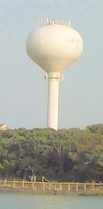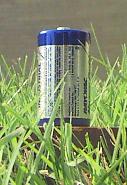

A battery causes current to flow in a circuit. It is the electrical analog of a pump. Just as we can characterize a pump by the pressure it develops, we characterize a battery's strength by its voltage. It can be defined in terms of energy: a one volt battery will deliver 1 joule to an electrical circuit in one second, when a 1 ampere current is flowing.
The standard flashlight battery produces 1.5 V. When they are stacked end-to-end, the voltages add. The bulb of a two-cell flashlight is designed to work best with 3 volts applied to it, and so we stack the batteries to accomplish this.
 |
A battery is similar to a water tower: it provides electrical pressure. Connecting batteries in series is the equivalent of building a taller water tower. |  |
The flow rate of a liquid in a pipe is determined by the pressure difference between one end of the pipe and the other, and by various other factors such as the length and diameter of the pipe. A wide pipe permits a large flow rate, while a long one tends to decrease the flow. We can also imagine that there is a difference between pipes that are rough and smooth inside.
We can say something very similar about electricity. The current (measured in amperes) in a wire is determined by the voltage difference between one end of the wire and the other, and by various other factors such as the length and diameter of the wire. A thick wire permits a large current, while a long one tends to decrease it. There is also a difference between wires made of different materials. The property of a wire or a device that limits the current is called its electrical resistance. A high resistance wire will not permit much current to flow, unless a high voltage is applied. This is similar to trying to move a lot of water through a long, thin tube: a high pressure is required.